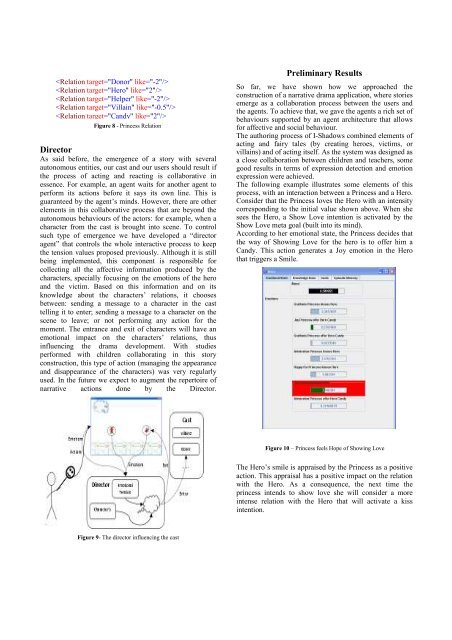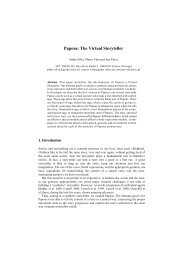Are we telling the same story? Balancing real and ... - ResearchGate
Are we telling the same story? Balancing real and ... - ResearchGate
Are we telling the same story? Balancing real and ... - ResearchGate
- No tags were found...
You also want an ePaper? Increase the reach of your titles
YUMPU automatically turns print PDFs into web optimized ePapers that Google loves.
Figure 8 - Princess RelationDirectorAs said before, <strong>the</strong> emergence of a <strong>story</strong> with severalautonomous entities, our cast <strong>and</strong> our users should result if<strong>the</strong> process of acting <strong>and</strong> reacting is collaborative inessence. For example, an agent waits for ano<strong>the</strong>r agent toperform its actions before it says its own line. This isguaranteed by <strong>the</strong> agent’s minds. Ho<strong>we</strong>ver, <strong>the</strong>re are o<strong>the</strong>relements in this collaborative process that are beyond <strong>the</strong>autonomous behaviours of <strong>the</strong> actors: for example, when acharacter from <strong>the</strong> cast is brought into scene. To controlsuch type of emergence <strong>we</strong> have developed a “directoragent” that controls <strong>the</strong> whole interactive process to keep<strong>the</strong> tension values proposed previously. Although it is stillbeing implemented, this component is responsible forcollecting all <strong>the</strong> affective information produced by <strong>the</strong>characters, specially focusing on <strong>the</strong> emotions of <strong>the</strong> hero<strong>and</strong> <strong>the</strong> victim. Based on this information <strong>and</strong> on itsknowledge about <strong>the</strong> characters’ relations, it choosesbet<strong>we</strong>en: sending a message to a character in <strong>the</strong> cast<strong>telling</strong> it to enter; sending a message to a character on <strong>the</strong>scene to leave; or not performing any action for <strong>the</strong>moment. The entrance <strong>and</strong> exit of characters will have anemotional impact on <strong>the</strong> characters’ relations, thusinfluencing <strong>the</strong> drama development. With studiesperformed with children collaborating in this <strong>story</strong>construction, this type of action (managing <strong>the</strong> appearance<strong>and</strong> disappearance of <strong>the</strong> characters) was very regularlyused. In <strong>the</strong> future <strong>we</strong> expect to augment <strong>the</strong> repertoire ofnarrative actions done by <strong>the</strong> Director.Preliminary ResultsSo far, <strong>we</strong> have shown how <strong>we</strong> approached <strong>the</strong>construction of a narrative drama application, where storiesemerge as a collaboration process bet<strong>we</strong>en <strong>the</strong> users <strong>and</strong><strong>the</strong> agents. To achieve that, <strong>we</strong> gave <strong>the</strong> agents a rich set ofbehaviours supported by an agent architecture that allowsfor affective <strong>and</strong> social behaviour.The authoring process of I-Shadows combined elements ofacting <strong>and</strong> fairy tales (by creating heroes, victims, orvillains) <strong>and</strong> of acting itself. As <strong>the</strong> system was designed asa close collaboration bet<strong>we</strong>en children <strong>and</strong> teachers, somegood results in terms of expression detection <strong>and</strong> emotionexpression <strong>we</strong>re achieved.The following example illustrates some elements of thisprocess, with an interaction bet<strong>we</strong>en a Princess <strong>and</strong> a Hero.Consider that <strong>the</strong> Princess loves <strong>the</strong> Hero with an intensitycorresponding to <strong>the</strong> initial value shown above. When shesees <strong>the</strong> Hero, a Show Love intention is activated by <strong>the</strong>Show Love meta goal (built into its mind).According to her emotional state, <strong>the</strong> Princess decides that<strong>the</strong> way of Showing Love for <strong>the</strong> hero is to offer him aC<strong>and</strong>y. This action generates a Joy emotion in <strong>the</strong> Herothat triggers a Smile.Figure 10 – Princess feels Hope of Showing LoveThe Hero’s smile is appraised by <strong>the</strong> Princess as a positiveaction. This appraisal has a positive impact on <strong>the</strong> relationwith <strong>the</strong> Hero. As a consequence, <strong>the</strong> next time <strong>the</strong>princess intends to show love she will consider a moreintense relation with <strong>the</strong> Hero that will activate a kissintention.Figure 9- The director influencing <strong>the</strong> cast






